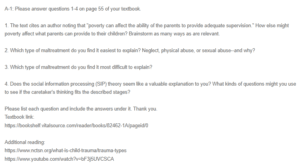Discussion – Child Maltreatment
Poverty can have a multifaceted impact on parents’ ability to provide for their children. Examples of this include malnutrition. Limited financial resources may lead to inadequate access to nutritious food, affecting the child’s physical and cognitive development. Secondly, it may impact parents’ ability to provide emotional support due to the high-stress levels associated with poverty, affecting the child’s mental health (Royse & Griffiths, 2020). Additionally, poverty may impact parental time. Working multiple jobs or long hours to make ends meet can reduce the time parents have available for their children, affecting the quality of parent-child interactions. Subsequently, the children’s safety and security may be impacted as living in economically disadvantaged neighbourhoods may expose children to higher levels of crime and limited safety measures.
Furthermore, financial constraints may result in limited access to healthcare services, impacting the child’s overall health and well-being (Royse & Griffiths, 2020). Also, poverty may lead to a lack of access to quality education. Insufficient funds can restrict opportunities for quality education, including access to tutoring, extracurricular activities, and educational resources. Lastly, poverty may lead to a lack of access to proper housing. Low-income families may live in substandard housing conditions, affecting the child’s physical health and overall quality of life.
I find neglect to be the easiest form of neglect to explain compared to sexual and physical abuse. Neglect involves the failure to provide for a child’s basic needs, such as food, shelter, and supervision (Center on Developing Child at Harvard University, 2013). The absence of these fundamental requirements is relatively clear-cut and can be explained in terms of the caregiver not meeting their responsibilities. This is becoming even more prevalent as the number of single parents raising their children alone grows.
On the other hand, physical abuse involves intentional harm or injury inflicted on a child through actions like beating or slapping while sexual abuse involves inappropriate sexual behaviour or exploitation (Royse & Griffiths, 2020). Both physical and sexual abuse may involve complex factors, including power dynamics, secrecy, and the emotional impact on the child, making them more challenging to articulate. Following, this, I believe that sexual abuse is the most difficult to explain mainly because I fail to understand what leads anyone to engage in such an act, especially towards children.
Nonetheless, it is crucial to approach discussions about child maltreatment with care and sensitivity. While neglect may seem more straightforward to explain, it doesn’t diminish the seriousness of the issue or the potential long-term consequences for the child. All forms of maltreatment warrant attention and intervention to ensure the safety and well-being of children. It’s also important to recognize that the severity and impact of neglect, physical abuse, and sexual abuse can vary widely depending on the specific circumstances and the individual child involved.
SIP theory does seem like a valuable explanation for child maltreatment behaviour. However, I think SIP theory is just one lens through which to understand social behaviours, and child maltreatment is a complex phenomenon influenced by various factors. Other theories, such as attachment theory, ecological systems theory, and trauma-informed perspectives, also play crucial roles in comprehensively understanding the dynamics of child maltreatment behaviours. Some of the questions I would ask a caregiver in order to determine if their thinking fits the SIPS described stages would be as follows. For stage one to question the caregiver’s attentiveness to children, I would ask for instances where they saw children express their emotions uniquely. For stage two, I would ask questions that shed light on whether the caregiver has a bias towards viewing children as intentional deviants. For stages three and four, I would ask questions to learn more about a caregiver’s disciplinary strategy for example if they are flexible when it comes to finding the appropriate punishment or not.
References
Center on Developing Child at Harvard University. (2013, October 31). In Brief: The Science of Neglect. [Video]. YouTube. https://www.youtube.com/watch?v=bF3j5UVCSCA
Royse, D. D., & Griffiths, A. G. (2020). Child welfare and child protection: An introduction. Cognella Academic Publishing.
ORDER A PLAGIARISM-FREE PAPER HERE
We’ll write everything from scratch
Question
A-1: Please answer questions 1-4 on page 55 of your textbook.
1. The text cites an author noting that “poverty can affect the ability of the parents to provide adequate supervision.” How else might poverty affect what parents can provide to their children? Brainstorm as many ways as are relevant.

Discussion – Child Maltreatment
2. Which type of maltreatment do you find it easiest to explain? Neglect, physical abuse, or sexual abuse–and why?
3. Which type of maltreatment do you find it most difficult to explain?
4. Does the social information processing (SIP) theory seem like a valuable explanation to you? What kinds of questions might you use to see if the caretaker’s thinking fits the described stages?
Please list each question and include the answers under it. Thank you.
Textbook link:
https://bookshelf.vitalsource.com/reader/books/82462-1A/pageid/0
Additional reading:
https://www.nctsn.org/what-is-child-trauma/trauma-types
https://www.youtube.com/watch?v=bF3j5UVCSCA

